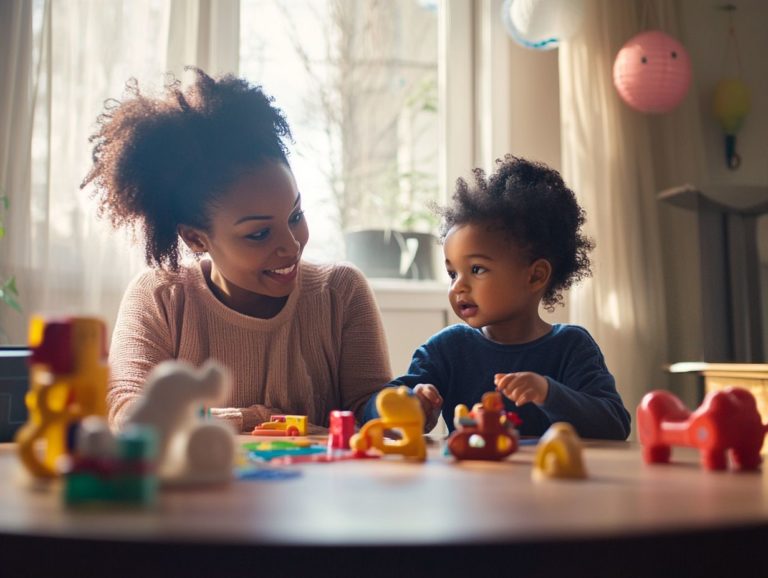Practicing Mindful Listening at Home
In today s fast-paced world, the art of truly hearing one another often takes a back seat, particularly within the sanctuary of your own home. This is where mindful practices like attentive listening can make a significant difference.
Mindful listening emerges as a transformative practice, inviting you to be fully present and engaged in your conversations. This approach builds stronger connections with your loved ones, allowing personal relationships and therapeutic relationships to flourish.
Let s explore the essence of mindful listening, highlighting its significance in cultivating a harmonious home environment. You’ll find effective listening techniques and strategies to nurture this invaluable skill.
Embrace mindful listening and unlock the potential to enhance communication, strengthen relationships, and improve family dynamics in your life, paving the way for healthier interactions and stronger family bonds.
Contents
- Key Takeaways:
- What Is Mindful Listening?
- Why Is Mindful Listening Important at Home?
- How to Practice Mindful Listening at Home?
- What Are the Benefits of Mindful Listening at Home?
- How Can Mindful Listening Improve Family Dynamics?
- 1. Promotes a Positive and Supportive Atmosphere
- 2. Encourages Open and Honest Communication
- 3. Fosters Mutual Respect and Empathy
- 4. The Role of Mindful Listening in Conflict Resolution
- Frequently Asked Questions
- What is meant by practicing mindful listening at home?
- How can I practice mindful listening at home?
- Why is practicing mindful listening important at home?
- What are some tips for becoming a better mindful listener at home?
- How can I encourage my family members to practice mindful listening at home?
- What are some ways to incorporate mindful listening into daily family interactions at home?
Key Takeaways:

- Practice mindful listening by creating a safe and distraction-free environment to foster open and honest communication at home.
- Show empathy and understanding through active listening techniques to improve relationships and reduce conflicts with your family.
- Mindful listening enhances family dynamics by promoting a positive atmosphere, encouraging respect and empathy, and helping to resolve conflicts.
- Utilize various listening exercises to enhance your listening abilities and attention span.
- Manage distractions effectively to maintain attention focus during conversations.
What Is Mindful Listening?
Mindful listening is an active and intentional approach that invites you to be fully present and engaged in every conversation. It goes beyond mere hearing; it requires you to sharpen your communication skills, paying close attention to nonverbal cues, managing distractions, and employing reflective listening techniques, which involve listening carefully and responding thoughtfully.
This practice fosters a deeper emotional understanding between you and others. By embracing mindful listening, you can enhance your emotional intelligence, strengthen your personal relationships, and cultivate a supportive communication environment that nurtures effective dialogue and builds deeper connections.
Why Is Mindful Listening Important at Home?
Mindful listening holds great importance in your home environment, as it nurtures healthy interactions and fortifies personal relationships among family members.
By fully engaging and practicing empathy, you can effectively reduce communication barriers and enhance emotional understanding. This leads to a supportive atmosphere that encourages open dialogue and trust, essential elements of successful therapeutic alliances.
Embracing this intentional practice cultivates stronger family bonds and helps manage the distractions that frequently impede effective communication.
How to Practice Mindful Listening at Home?
Practicing mindful listening at home invites you to embrace a range of techniques that enhance engagement and presence during conversations. This means minimizing distractions, honing your active listening skills, and implementing effective strategies tailored to foster deeper connections and communication dynamics.
By cultivating a conducive listening environment, family members can partake in exercises designed to boost attention spans and listening abilities, ultimately enriching conversations and strengthening bonds. Engaging in this practice elevates emotional intelligence and equips you to navigate the listening challenges that may surface within family dynamics.
In conclusion, practicing mindful listening creates a foundation for stronger relationships and effective communication at home. Make an effort to incorporate these techniques into your daily interactions and experience the positive changes it can bring to your family dynamics.
1. Create a Safe and Comfortable Environment for Mindful Listening
Creating a safe and comfortable environment is crucial for mindful listening. It promotes open expression and vulnerability during conversations.
This involves setting up a welcoming space free from distractions. Here, everyone feels secure enough to share thoughts and feelings openly.
A supportive listening environment encourages good conversations and enhances your communication skills. It allows family members to delve into deeper discussions without the fear of being judged.
You can easily achieve this by focusing on the physical aspects of your environment! Comfortable seating arrangements and suitable lighting can significantly help in putting everyone at ease.
Emotional safety is reinforced through active reassurance, demonstrating empathy, and building trust among participants. Nonverbal cues, such as maintaining eye contact, nodding, and using open body language, are essential in conveying your attentiveness and support.
These elements work together to create a nurturing atmosphere where each participant feels valued and understood. This enriches your experience of mindful listening in profound ways.
2. Put Away Distractions
To practice mindful listening, you must actively manage distractions that could disrupt your focus and hinder effective communication. This means turning off electronic devices, setting aside the whirlwind of busy thoughts, and creating a distraction-free zone for your conversations.
By minimizing these distractions, you can significantly enhance your listening skills and overcome common challenges. This paves the way for more meaningful interactions and deeper connections.
Establishing a routine before discussions can be incredibly beneficial. Consider incorporating deep breathing exercises to calm your mind and prepare for active listening.
Positioning yourself in a quiet space can help you manage external distractions and encourage the other party to follow suit. Internally, you might visualize the conversation ahead or use positive affirmations to sharpen your focus.
These strategies cultivate an environment ideal for attentive listening and empower you to engage authentically. This ensures that your communication remains fluid and impactful.
Addressing potential listening pitfalls and barriers helps maintain a positive conversation flow.
3. Use Active Listening Techniques

Active listening techniques are essential for elevating your mindful listening game. They foster engagement and understanding during conversations.
Techniques such as paraphrasing, asking open-ended questions, and providing reflective listening responses encourage deeper dialogue and clarity.
By incorporating these strategies, you can significantly enhance your communication skills and cultivate an atmosphere rich in respect and empathy.
For example, when parents actively listen to their children, they might reflect back what their kids say to ensure understanding. This validates their feelings in the process.
Asking open-ended questions can lead to more enriching exchanges, allowing children to express themselves with greater freedom. In the comfort of your home, embracing these strategies strengthens familial bonds and instills crucial communication skills and social skills in children.
Practicing techniques like summarizing helps everyone involved feel acknowledged. This reinforces trust and openness in your discussions.
Ultimately, mastering active listening can transform your everyday interactions. It creates a culture of empathy and respect that benefits everyone involved.
4. Be Present and Engaged
Being present and engaged during conversations is essential for mindful listening. It allows you to fully absorb the speaker’s message and respond with intention.
This means actively participating in the dialogue, demonstrating genuine interest, and listening without judgment. By building emotional connections, you can establish deeper connections, significantly enhancing the quality of your interactions.
Understanding the nuances of communication goes beyond merely hearing words; it requires you to observe body language and emotional cues. To cultivate mindfulness, techniques like deep breathing and maintaining eye contact can be invaluable, helping you stay centered and focused.
Encouraging questions and reflections can also elevate the dialogue, creating a more immersive exchange of ideas and perspectives. Ultimately, prioritizing a non-judgmental approach in discussions not only strengthens your interpersonal bonds but also nurtures a sense of safety and trust in sharing thoughts, paving the way for meaningful connections.
5. Show Empathy and Understanding
Demonstrating empathy and understanding is essential for mindful listening, as it fortifies the emotional bond between speakers and listeners. By honing your empathy skills, you can reflect on the emotions being expressed and validate the speaker’s feelings, thereby fostering supportive communication.
This approach enhances your emotional intelligence and self-awareness, paving the way for rich conversations that bring forth a plethora of listening benefits.
To truly embody mindful listening, engage in each conversation with genuine curiosity and an open heart. For instance, when someone shares a personal story, simple gestures like nodding, maintaining eye contact, or verbally acknowledging their feelings such as saying, “That sounds really challenging” can convey profound empathy.
This kind of validation not only reassures the speaker that their feelings are heard and respected but also encourages a deeper level of sharing and connection.
As a result, the dynamics of communication shift. Conversations become more collaborative and fluid, ultimately leading to stronger relationships and richer interactions. This improved conversation flow can be pivotal in both personal and professional settings.
What Are the Benefits of Mindful Listening at Home?
Practicing mindful listening at home offers a wealth of benefits, greatly enhancing communication and understanding among family members. By fostering a culture of active engagement and empathy, you can improve interpersonal relationships and cultivate an environment that encourages supportive communication practices.
These benefits dramatically cut down conflicts and create a harmonious home! They contribute to heightened emotional intelligence and an overall sense of harmony within your household, improving both your personal relationships and therapeutic relationships.
1. Improves Communication and Understanding
One of the primary benefits of mindful listening is its remarkable ability to enhance communication and understanding among family members. By employing effective listening techniques, such as reflective listening (which means repeating back what the speaker has said to show understanding) and active engagement, you can convey empathy and emotional insight.
This paves the way for clearer and more meaningful exchanges, improving your overall communication skills.
Incorporating these practices cultivates an atmosphere where family members feel genuinely heard and valued, significantly boosting relational dynamics. For instance, when you practice attentive listening, you re more inclined to ask open-ended questions that encourage deeper conversations.
Nonverbal cues and body language play a vital role here; maintaining eye contact and embracing an open body posture signal your genuine interest.
As family discussions unfold, they often become richer and more productive. Participants learn to read between the lines, uncovering underlying feelings and concerns that might otherwise remain unvoiced.
Ultimately, these techniques not only bridge communication gaps but also fortify emotional bonds within the family.
2. Builds Stronger Relationships
Practicing mindful listening significantly enhances your relationships. It fosters trust and emotional connection with those around you. This intentional communication approach elevates your emotional intelligence, allowing family members to feel validated and understood. Ultimately, this fortifies relationships and strengthens social skills.
When you engage in mindful listening, you cultivate an atmosphere where feelings and thoughts can be shared openly. For example, during a heated discussion about household responsibilities, instead of interrupting or dismissing concerns, taking the time to genuinely understand what each person is expressing demonstrates profound respect and empathy.
This supportive style of communication aids in conflict resolution. It nurtures emotional connections by affirming that each person s perspective holds value. As you become more attuned to each other s emotional states, your interactions will transform, leading to deeper understanding and collaboration in daily life. Ultimately, this strengthens the family unit.
3. Reduces Conflicts and Misunderstandings Through Effective Listening

Mindful listening has the power to significantly reduce conflicts and misunderstandings by effectively addressing the communication barriers that often lead to emotional discord. When you actively practice listening strategies, such as managing distractions and maintaining attention focus, you can clarify your intentions and feelings. This helps resolve potential conflicts before they escalate into something more serious.
This approach strengthens your relationships and cultivates an environment of trust and empathy within your family. Techniques such as paraphrasing where you reflect back what you’ve heard and asking open-ended questions can greatly enhance clarity. They help prevent assumptions from taking root.
Maintaining an open body posture and making eye contact can convey genuine interest, making the speaker feel valued and heard. By embracing these intentional listening practices, you create a space where family members can express their thoughts without the fear of judgment. This ultimately paves the way for healthier discussions and deeper mutual understanding.
4. Increases Trust and Bonding
Mindful listening is your secret weapon for enhancing trust and bonding among family members! By creating a safe space for open dialogue and emotional sharing, you invite a deeper connection. When you ensure that individuals feel heard and understood, it nurtures a sense of belonging and fortifies the emotional ties that unite everyone.
Consider your family dinners; by prioritizing attentive listening, you can transform these routine interactions into meaningful moments of connection. Picture a scenario where your teenager opens up about struggles at school. Instead of immediately jumping in with solutions, you take a step back to actively listen. This validates their feelings and encourages honest expression. This approach showcases your empathy and reinforces a sense of safety, allowing your family members to embrace vulnerability.
With time, these intentional practices cultivate a supportive atmosphere where emotional understanding thrives. This leads to stronger familial solidarity and resilience, particularly when navigating life’s challenges.
How Can Mindful Listening Improve Family Dynamics?
Mindful listening can profoundly enhance family dynamics, cultivating a positive atmosphere where open communication flourishes. By embracing active listening and empathy, you can help create a nurturing environment that encourages mutual respect and understanding among family members.
These principles elevate emotional intelligence and pave the way for healthier interactions within the family unit.
1. Promotes a Positive and Supportive Atmosphere
By practicing active listening, you can foster a positive and supportive atmosphere within your family. This encourages everyone to express their thoughts and feelings without the fear of judgment. Such a nurturing environment enhances emotional understanding and self-awareness, leading to deeper connections and healthier interactions among family members.
When you engage actively, it opens the door to a richer understanding of each person s perspective. This can effectively diffuse conflicts and prevent misunderstandings. This approach validates emotions, signaling that each person’s feelings are important and builds trust and openness among family members.
Creating a home that prioritizes supportive communication transforms your family life. It creates a safe space for vulnerability, ultimately enhancing emotional resilience. Such communication inspires individuals to share their experiences candidly, strengthening familial bonds and promoting unity, turning your home into a haven of mutual respect and empathy.
2. Encourages Open and Honest Communication
Active listening fosters an atmosphere of open and honest communication, providing family members with a safe space to share their thoughts and feelings without hesitation. This practice enhances emotional intelligence and employs effective listening techniques that validate each person’s unique perspective.
When you actively engage in listening, you shift your focus toward understanding the experiences of others rather than merely waiting for your turn to speak. For instance, during a dinner conversation, imagine a parent asking their child about a challenging day at school and genuinely listening without rushing to offer solutions. This improves your listening mindfulness and nurtures deeper connections within the family.
Incorporating techniques like reflective listening, where you paraphrase what someone else has said, can significantly reinforce understanding and respect. By doing so, your family cultivates a culture of transparency and empathy, allowing each member to express their emotions authentically and without fear, thus improving communication techniques.
3. Fosters Mutual Respect and Empathy
Fostering mutual respect and empathy is essential in practicing active listening. This enables you and your family members to truly understand and appreciate each other’s feelings and experiences. Such practice sharpens empathy skills, leading to supportive communication and deeper emotional connections.
When you engage in active listening, you show your commitment to valuing each other s perspectives. This cultivates an environment where open dialogues can flourish. When individuals feel heard and understood, they’re more likely to express their authentic selves, reducing misunderstandings and fostering a sense of security within your family unit.
As these vital values of mutual respect and empathy weave into your daily interactions, the family dynamic strengthens. This creates a nurturing environment where everyone can grow and collaborate. Ultimately, this approach enriches your relationships and establishes a lasting legacy of understanding that will benefit future generations.
4. The Role of Mindful Listening in Conflict Resolution

Mindful listening is essential in resolving conflicts and disagreements within your family. It nurtures emotional understanding and encourages effective listening strategies along with mindful practices.
Engaging in conversations helps you address issues effectively. This approach cultivates empathy and gives the power to everyone to express their feelings openly and honestly.
Techniques like reflective listening, which means repeating back what someone has said to confirm you understand them, or paraphrasing to ensure clarity, significantly enhance communication.
These strategies allow everyone to feel heard and validated, creating a safe space for meaningful dialogue! They also improve listening responses.
Maintaining eye contact and using affirming nods during discussions are simple yet powerful ways to demonstrate attentiveness. This signals to each family member that their perspectives truly matter, hence improving listening strategies.
Incorporating mindful listening practices can lead to healthier relationships and stronger family bonds. This paves the way for lasting resolutions and client success.
Frequently Asked Questions
What is meant by practicing mindful listening at home?
Practicing mindful listening at home means being fully present and engaged in listening to someone without any distractions or judgment.
How can I practice mindful listening at home?
You can practice mindful listening at home by setting aside distractions, maintaining eye contact, and actively listening to the speaker without interrupting.
Why is practicing mindful listening important at home?
Practicing mindful listening at home can help improve communication and strengthen relationships with family members. This leads to a more harmonious and peaceful home environment.
What are some tips for becoming a better mindful listener at home?
Some tips for becoming a better mindful listener at home include taking deep breaths, being non-judgmental, and reflecting back on what the speaker is saying.
How can I encourage my family members to practice mindful listening at home?
You can encourage your family members to practice mindful listening by setting an example yourself and initiating open, honest communication about the benefits of mindful listening.
What are some ways to incorporate mindful listening into daily family interactions at home?
Incorporating mindful listening into daily family interactions can be done by having designated listening times, using active listening techniques, and showing appreciation for each other’s thoughts and feelings.






